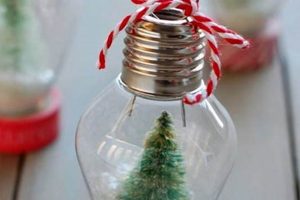The creation of personalized festive decorations for external seasonal display involves individual crafting and construction. These handcrafted items, intended for placement in yards, on porches, or affixed to exterior structures, offer an alternative to commercially manufactured holiday adornments. Examples include repurposed pallet Christmas trees, hand-painted wooden snowmen, and illuminated mason jar lanterns.
Employing this practice provides a cost-effective means of holiday decorating, leveraging readily available materials and minimizing expenditure on store-bought alternatives. Furthermore, it allows for a high degree of personalization, reflecting individual artistic expression and complementing existing architectural and landscape designs. Historically, handcrafted decorations have been a significant part of Christmas celebrations, demonstrating resourcefulness and community involvement.
The subsequent discussion will examine various methods for producing these decorations, focusing on material selection, construction techniques, and safety considerations for outdoor installation. Attention will also be given to design principles that maximize visual impact and withstand exposure to environmental elements.
Guidance for Constructing External Holiday Embellishments
The following recommendations are intended to improve the longevity, visual appeal, and safety of self-made festive decorations intended for outdoor placement.
Tip 1: Material Selection for Weather Resistance: Prioritize materials capable of withstanding environmental exposure. Treated lumber, exterior-grade paints, and weather-resistant fabrics are recommended. Avoid using materials prone to rapid degradation from moisture, sunlight, or temperature fluctuations. For example, untreated particleboard should be avoided in favor of pressure-treated plywood.
Tip 2: Secure Fastening and Installation: Employ robust fastening methods to ensure stability and prevent dislodgement due to wind or inclement weather. Utilize appropriate screws, bolts, and adhesives rated for outdoor use. Ensure proper anchoring to surfaces, considering load-bearing capacity and potential wind resistance. For example, ornaments suspended from trees should be secured with durable, weather-resistant rope or wire, not thin twine.
Tip 3: Illumination Safety Protocols: When incorporating electrical components, adhere strictly to safety standards and local electrical codes. Utilize only UL-listed outdoor-rated lights and extension cords. Inspect wiring for damage before installation and ensure proper grounding. Avoid overloading circuits. For example, use low-voltage LED lights to minimize energy consumption and reduce the risk of overheating.
Tip 4: Prioritize Visibility and Scale: Design ornaments with consideration for viewing distance and surrounding landscape. Utilize scale appropriately to ensure visibility from the street or other vantage points. Consider the color palette and its contrast against the backdrop. For example, a small, dark ornament placed against a dark-colored fence may be difficult to see from a distance.
Tip 5: Repurposing and Upcycling Strategies: Explore opportunities to repurpose existing materials or upcycle discarded items. This approach reduces material costs and promotes sustainability. Consider transforming old tires into festive wreaths or using reclaimed wood to construct decorative signs. For example, discarded plastic bottles can be painted and assembled into illuminated sculptures.
Tip 6: Storage Considerations: Plan for efficient and protective storage during the off-season. Disassemble ornaments when feasible and store them in watertight containers in a dry, climate-controlled environment. This practice will prolong the lifespan of the decorations and minimize the need for repairs or replacements. For example, delicate ornaments should be individually wrapped to prevent breakage.
The careful application of these recommendations will enhance the aesthetic appeal, safety, and longevity of holiday decorations, ensuring a festive display for years to come.
The concluding section will summarize the critical elements of successful outdoor decoration projects and explore potential avenues for further creative exploration.
1. Material Weather Resistance
Material weather resistance is a critical factor in the design and construction of external seasonal decorations. The selection of appropriate materials directly impacts the longevity, structural integrity, and overall aesthetic appeal of handcrafted holiday ornaments designed for outdoor display.
- Resistance to Moisture and Precipitation
Materials must withstand prolonged exposure to rain, snow, and humidity without succumbing to rot, rust, or delamination. Treated lumber, exterior-grade paints, and rust-proof metals are suitable choices. The failure to select moisture-resistant materials can lead to rapid degradation and structural failure, rendering the ornament unusable within a single season.
- Resistance to Ultraviolet Radiation
Extended exposure to sunlight, particularly ultraviolet (UV) radiation, can cause fading, discoloration, and embrittlement of many materials. Paints and coatings formulated with UV inhibitors offer protection. Plastics lacking UV stabilizers may become brittle and crack over time. Shielding decorations from direct sunlight when possible can also mitigate UV damage.
- Resistance to Temperature Fluctuations
Outdoor decorations are subject to significant temperature variations, including freezing temperatures and intense heat. Materials must be able to withstand expansion and contraction without cracking or warping. Flexible materials, such as certain types of plastics and rubbers, can accommodate temperature changes more effectively than rigid materials like glass or brittle polymers.
- Resistance to Wind and Physical Impact
External decorations must be robust enough to withstand wind loads and potential impacts from falling debris or accidental contact. Lightweight materials may be easily dislodged or damaged by strong winds. Sturdy construction techniques, such as reinforced joints and secure anchoring, are essential for enhancing overall durability.
These considerations are paramount in ensuring that festive displays remain visually appealing and structurally sound throughout the holiday season and beyond. Careful material selection minimizes the need for frequent repairs or replacements, providing long-term cost savings and reducing environmental impact by extending the lifespan of self-made festive decorations.
2. Structural Integrity
Structural integrity, in the context of handcrafted exterior seasonal decorations, refers to the capacity of the ornament to withstand environmental stressors and maintain its form and function over time. It is a critical factor in determining the longevity, safety, and overall effectiveness of such decorations.
- Joint Stability and Fastening Methods
The manner in which individual components are joined and secured dictates the overall structural stability of the ornament. Weak joints can lead to component separation and eventual collapse under wind or snow load. Appropriate fastening methods, such as screws, bolts, or weatherproof adhesives, must be selected based on the materials being joined and the anticipated stress levels. For example, a large wooden star assembled with insufficient glue or small nails may disintegrate during a winter storm.
- Material Strength and Load-Bearing Capacity
Each material used in the construction contributes to the ornament’s ability to bear its own weight and resist external forces. The selection of materials with adequate strength and rigidity is essential. A lightweight plastic ornament may be suitable for hanging from a tree branch, while a larger, heavier ornament requires a more robust support structure. The load-bearing capacity of supporting elements, such as hanging wires or mounting brackets, must also be considered.
- Aerodynamic Considerations and Wind Resistance
The shape and surface area of the ornament influence its susceptibility to wind forces. Large, flat surfaces are more likely to experience significant wind resistance, potentially leading to dislodgement or damage. Incorporating aerodynamic design principles, such as rounded edges or strategically placed openings, can reduce wind resistance and improve stability. Proper anchoring and secure attachment to a stable structure are also crucial for minimizing wind-related risks.
- Resistance to Degradation and Material Fatigue
Prolonged exposure to environmental elements can cause materials to degrade over time, reducing their structural strength and increasing the risk of failure. UV radiation, moisture, and temperature fluctuations can all contribute to material fatigue. Selecting weather-resistant materials and applying protective coatings can mitigate these effects and extend the lifespan of the ornament. Regular inspection and maintenance can also help identify and address potential structural weaknesses before they lead to catastrophic failure.
The integration of these structural considerations is paramount to ensuring that individually crafted seasonal decorations remain visually appealing and structurally sound throughout the holiday season and beyond. A focus on robust design and construction practices minimizes the risk of damage or failure, enhancing the safety and enjoyment of outdoor festive displays.
3. Visual Harmony
Visual harmony, in the context of handcrafted exterior seasonal adornments, denotes the coherent and aesthetically pleasing integration of decorations with the surrounding environment. It represents a conscious effort to ensure that the ornaments complement, rather than clash with, the existing architectural style, landscape design, and overall visual character of the property. Attaining visual harmony enhances the festive ambiance while maintaining aesthetic integrity.
- Color Palette Integration
The selection of colors used in exterior decorations should align with the existing color scheme of the house and yard. Complementary colors, analogous colors, or a monochromatic palette can create a cohesive visual effect. For example, a house with warm-toned brick might benefit from decorations featuring reds, oranges, and golds, while a house with cool-toned siding might be better suited for decorations featuring blues, silvers, and whites. The use of contrasting colors should be deliberate and carefully considered to avoid visual discord.
- Scale and Proportion Considerations
The size and proportions of decorations must be appropriate for the scale of the house and yard. Overly large ornaments can overwhelm the visual space, while overly small ornaments may be lost or appear insignificant. Decorations should be scaled to complement the architectural features of the house, such as the size of the windows, doors, and roofline. Similarly, the size of yard ornaments should be proportionate to the size of the lawn and garden beds. A miniature snowman in front of a large Victorian house may seem out of place, while a towering inflatable decoration in a small front yard may appear cramped and overwhelming.
- Style and Theme Consistency
Maintaining a consistent style and theme throughout the exterior decoration scheme contributes significantly to visual harmony. Mixing disparate styles, such as rustic country and modern minimalist, can create a jarring effect. Selecting a unifying theme, such as traditional Victorian, whimsical folk art, or contemporary geometric, helps to create a cohesive and intentional design. For example, a house decorated with elegant Victorian-style wreaths and garlands may be complemented by handcrafted wooden reindeer, while a modern house may be enhanced by minimalist geometric ornaments made from metal or glass.
- Lighting Integration and Ambiance
The type, color, and intensity of lighting used in exterior decorations can significantly impact the overall visual harmony. Soft, warm white lights often create a welcoming and festive ambiance, while harsh, bright lights may appear garish and intrusive. The placement of lights should be carefully considered to highlight architectural features and create visual interest without overwhelming the space. Subtle accent lighting can enhance the texture and form of handcrafted ornaments, while strategic uplighting can create a dramatic effect. The color temperature of the lights should also be consistent to avoid a discordant appearance. For example, mixing cool white LED lights with warm yellow incandescent lights can create an unappealing visual contrast.
Consideration of the factors outlined assists in the creation of a visually compelling holiday display. The application of visual harmony principles ensures that the outcome enhances the aesthetic value of the property and establishes a festive presence. The careful selection and arrangement of decorative elements contributes to a cohesive and elegant presentation.
4. Safe Illumination
The integration of electrical lighting into self-constructed exterior holiday adornments presents inherent risks requiring thorough understanding and diligent application of safety protocols. Illumination enhances visibility and aesthetic appeal, yet improper execution can result in electrical hazards, fire risks, and potential physical harm.
- UL-Listed Components
The utilization of Underwriters Laboratories (UL)-listed components is paramount for safe operation. UL listing signifies that electrical products have undergone rigorous testing to meet established safety standards. Extension cords, light strings, and other electrical components lacking UL certification present a heightened risk of malfunction, overheating, and electrical shock. For instance, utilizing non-UL-listed light strings, often sourced from unverified vendors, increases the probability of insulation failure leading to short circuits.
- Weatherproof Enclosures and Connections
Exterior environments expose electrical connections to moisture, precipitation, and fluctuating temperatures. The employment of weatherproof enclosures and connections is essential to prevent water intrusion, corrosion, and electrical shorts. Electrical boxes and connectors rated for outdoor use provide a sealed environment that protects wiring from environmental elements. Failure to utilize weatherproof components can lead to equipment failure and create hazardous conditions, particularly in wet or snowy conditions.
- Ground Fault Circuit Interrupter (GFCI) Protection
GFCI outlets provide a critical safety measure by detecting ground faults and immediately interrupting the electrical circuit. Ground faults occur when electricity deviates from its intended path and flows through unintended conductors, such as a person. GFCI protection is essential for all outdoor electrical outlets and extension cords used in conjunction with decorations. The absence of GFCI protection significantly elevates the risk of electrical shock in the event of a ground fault.
- Proper Wiring and Insulation
Safe and reliable electrical connections require proper wiring techniques and adequate insulation. Wiring should be of appropriate gauge for the intended current load, and connections should be securely made using approved connectors. Insulation should be intact and free from damage to prevent electrical shorts and potential fire hazards. Damaged or frayed wiring should be replaced immediately. For example, pinching electrical wiring during decoration installation can compromise insulation, creating an elevated risk of electrical shock.
Adherence to these safety guidelines ensures that the integration of illumination within individually crafted outdoor holiday decorations enhances the festive atmosphere without compromising safety. Careful planning, diligent execution, and consistent adherence to established safety standards are essential for minimizing risks and maximizing the longevity and enjoyment of these seasonal displays.
5. Seasonal Storage
Seasonal storage, in the context of handcrafted exterior seasonal adornments, encompasses the procedures and infrastructure necessary for preserving and protecting decorations during periods of non-use. Its effectiveness directly influences the longevity, structural integrity, and aesthetic quality of individually crafted outdoor ornaments. Inadequate seasonal storage can negate the time, effort, and resources invested in their creation.
- Environmental Protection
Protection from environmental elements is paramount. Exposure to moisture, extreme temperatures, and direct sunlight during storage can accelerate material degradation. Storing ornaments in a dry, climate-controlled environment minimizes the risk of rot, rust, fading, and embrittlement. For instance, storing wooden ornaments in a damp shed promotes fungal growth and decay, while prolonged exposure to sunlight can fade painted surfaces and weaken plastic components.
- Physical Damage Prevention
Proper storage techniques minimize the risk of physical damage. Ornaments should be protected from impacts, crushing, and abrasion. Utilizing appropriate containers, padding materials, and organizational strategies prevents breakage, scratching, and deformation. For example, delicate glass ornaments should be individually wrapped in bubble wrap or tissue paper and stored in sturdy boxes to prevent shattering.
- Pest Control Measures
Stored ornaments can become susceptible to pest infestations. Insects, rodents, and other pests can damage or destroy materials used in their construction. Implementing pest control measures, such as storing ornaments in sealed containers, using insect repellents, and inspecting storage areas regularly, minimizes the risk of infestation. For instance, fabric ornaments can attract moths and other fabric-eating insects if not properly protected.
- Organization and Inventory Management
Effective organization and inventory management facilitate easy retrieval and minimize the risk of loss or damage. Labeling containers, creating inventories, and utilizing systematic storage arrangements streamline the process of locating and accessing ornaments. For example, storing ornaments in a disorganized pile makes it difficult to find specific items and increases the risk of damage during retrieval.
Consideration of the factors outlined ensures that festive displays remain visually appealing, functional, and structurally sound for multiple holiday seasons. Careful planning and meticulous execution of these elements enhances the return on investment in material and personal time. The conscientious storage prolongs life expectancy, and reduces the overall environmental impact of decorating practices.
Frequently Asked Questions
The following addresses common inquiries and misconceptions regarding construction and maintenance of handcrafted outdoor festive decoration elements.
Question 1: What constitutes the most durable material selection for outdoor ornament construction?
The optimal material selection depends on specific project requirements and environmental conditions. However, pressure-treated lumber, exterior-grade plywood, and weather-resistant plastics generally offer superior durability compared to untreated wood or standard-grade plastics. The suitability of materials should be assessed based on their resistance to moisture, UV radiation, and temperature fluctuations.
Question 2: What fastening methods provide the most secure attachment of outdoor ornaments to structures?
Secure attachment requires fasteners rated for outdoor use and appropriate for the materials being joined. Screws, bolts, and weatherproof adhesives provide robust connections compared to nails or staples. The selection of fastener length and diameter should be based on the anticipated load and the thickness of the materials being joined. Pre-drilling pilot holes can prevent splitting or cracking of wood components.
Question 3: What safety precautions are essential when incorporating electrical lighting into outdoor decorations?
Electrical safety necessitates the use of UL-listed components, weatherproof enclosures, and GFCI protection. Wiring should be of appropriate gauge and free from damage. Overloading circuits should be avoided. Regular inspection of electrical connections and components is recommended to identify and address potential hazards. The use of low-voltage LED lighting minimizes energy consumption and reduces the risk of overheating.
Question 4: How can the visual impact of outdoor decorations be maximized without compromising aesthetic harmony?
Visual impact can be enhanced through strategic use of color, scale, and lighting. Decorations should complement the architectural style and landscape design of the property. The use of contrasting colors, varying textures, and strategically placed lighting can create visual interest without overwhelming the overall aesthetic. Scale and proportion should be carefully considered to ensure that decorations are appropriately sized for their surroundings.
Question 5: What constitutes the best practices for seasonal storage of outdoor decorations?
Optimal storage requires protection from environmental elements, physical damage, and pest infestations. Decorations should be stored in a dry, climate-controlled environment in sealed containers. Delicate ornaments should be individually wrapped to prevent breakage. Pest control measures, such as using insect repellents and inspecting storage areas regularly, are recommended.
Question 6: How can environmental sustainability be promoted in the creation and maintenance of outdoor decorations?
Sustainability can be enhanced through the use of repurposed materials, energy-efficient lighting, and responsible disposal practices. Repurposing discarded items reduces material costs and minimizes waste. Energy-efficient LED lighting minimizes energy consumption. Recycling or composting materials at the end of their lifespan reduces environmental impact.
The implementation of these guidelines will ensure secure, visually pleasing, and long-lasting seasonal displays.
The succeeding section will summarize previously mentioned information with a focus on project initiation strategies.
DIY Outdoor Christmas Ornaments
This exposition has explored the multifaceted considerations pertinent to the creation and implementation of “diy outdoor christmas ornaments.” Key aspects include material selection based on environmental resilience, structural integrity to withstand weather conditions, visual harmony within the existing landscape, adherence to safe illumination practices, and the implementation of effective seasonal storage methods. Neglecting these elements compromises the longevity, safety, and aesthetic value of such projects.
The deliberate application of these principles ensures that the construction of these decorations is approached with both creativity and responsibility. A commitment to sound construction and safety protocols ensures the continuation of this tradition, while minimizing potential hazards and maximizing its enduring visual impact on communities.







